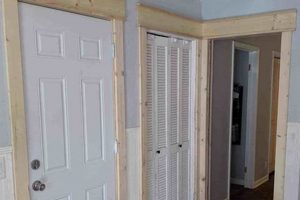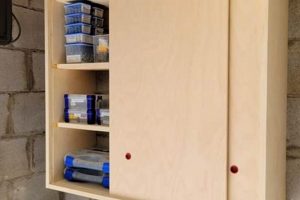The construction of a concealed entryway, often resembling a common storage unit, involves the creation of a movable partition designed to blend seamlessly with surrounding shelving. This type of portal is typically achieved through a combination of carpentry skills and hardware installation, resulting in a functional yet discreet access point. For example, a library might conceal a hidden room through such a mechanism, where a seemingly ordinary bookshelf slides aside to reveal the space beyond.
Such an implementation offers several advantages, including space optimization and enhanced security. By integrating a door into an existing wall of shelving, the need for a conventional swinging portal is eliminated, thus freeing up floor area. Historically, these hidden passages have been utilized to safeguard valuables, provide clandestine routes, or simply add an element of intrigue to a space. Their presence can increase property value and offer a unique design element.
The subsequent sections will delve into the specifics of designing and constructing such a feature, covering aspects such as material selection, hardware options, installation techniques, and safety considerations. Furthermore, potential design modifications and customization possibilities will be explored, enabling the creation of a personalized and functional hidden entryway.
Construction Considerations
Successful integration of a concealed bookshelf entrance necessitates careful planning and execution. The following guidelines are intended to assist in the creation of a functional and aesthetically pleasing design.
Tip 1: Structural Integrity: Evaluate the load-bearing capacity of the supporting wall. The weight of the bookshelf and its contents, coupled with the dynamic force of movement, must be adequately supported to prevent structural failure.
Tip 2: Hardware Selection: Utilize heavy-duty sliding door hardware specifically designed for the intended weight and frequency of operation. Ball-bearing rollers and robust track systems are crucial for smooth and reliable movement.
Tip 3: Precise Measurements: Accurately measure the opening and the bookshelf dimensions to ensure a snug fit and prevent binding. Account for any irregularities in the wall or floor to maintain a level and plumb installation.
Tip 4: Concealed Mechanism: Design the sliding mechanism to be as unobtrusive as possible. Consider incorporating trim or molding to conceal the track and hardware from view, enhancing the illusion of a standard bookshelf.
Tip 5: Safety Features: Implement safety mechanisms, such as locking mechanisms or anti-tip devices, to prevent accidental opening or collapse. Ensure the structure complies with local building codes and safety regulations.
Tip 6: Weight Distribution: Distribute the weight evenly across the shelves to prevent imbalances that could affect the sliding mechanism. Reinforce shelves as needed to accommodate heavy items.
Tip 7: Smooth Operation: Prioritize smooth and quiet operation by lubricating moving parts and ensuring proper alignment of the track and rollers. Regular maintenance will prolong the lifespan of the installation.
Adherence to these recommendations will contribute significantly to the creation of a secure, functional, and visually appealing hidden bookshelf entryway. Thorough planning and attention to detail are paramount to achieving a successful outcome.
The subsequent section will address advanced design techniques and customization options, allowing for the creation of truly unique and personalized hidden spaces.
1. Concealed Hardware
Concealed hardware represents a critical element in the successful execution of any bookshelf that doubles as a movable entry point. The primary objective is to maintain the illusion of a standard, stationary bookcase while providing smooth and reliable access. The efficacy of this concealment directly impacts the believability of the hidden passage. Visible tracks, rollers, or hinges immediately compromise the disguise, revealing its true function. Consequently, the selection and integration of hardware designed for unobtrusiveness are paramount to the overall success of the project. For instance, top-hung sliding systems, where the weight is supported from above, allow for the elimination of a floor-based track, a common visual giveaway.
The implementation of concealed hardware involves several practical considerations. Firstly, the hardware must be robust enough to support the weight of the loaded bookcase and withstand frequent use. This often necessitates the use of heavy-duty rollers and tracks, albeit designed to minimize their visual impact. Secondly, the installation requires precision to ensure smooth and quiet operation. Misalignment or improper fitting can lead to binding or noisy movement, further compromising the concealment. Thirdly, the access mechanism must be easily operated, allowing for effortless opening and closing without revealing its hidden nature. This may involve the integration of push-to-open latches or spring-loaded mechanisms that are activated with minimal force. A real-world example includes using magnetic latches with a weight capacity greater than the bookshelf load, to provide security and smooth accessibility.
In summary, concealed hardware is not merely an aesthetic choice but a functional imperative for a successful bookshelf access solution. Its proper selection and integration are essential for preserving the illusion, ensuring structural integrity, and providing ease of use. The challenges associated with concealment necessitate careful planning and meticulous execution, but the resulting enhancement of security, novelty, and space optimization justifies the effort. This element contributes significantly to the broader function, turning a standard storage unit into a feature enhancing the value of a property.
2. Structural Reinforcement
The successful integration of a bookcase as a movable portal is predicated upon robust structural reinforcement. The conversion of a stationary unit into a sliding entity introduces significant stress factors that necessitate comprehensive strengthening measures. A standard bookcase is designed to bear vertical loads; however, when mobilized, it must also withstand lateral forces associated with movement and the shifting weight of its contents. Failure to adequately reinforce the structure can result in warping, component separation, or even complete collapse, rendering the feature unsafe and inoperable. Therefore, structural reinforcement is not merely a desirable addition but a fundamental requirement for the creation of a functional and durable sliding bookcase.
The methods of reinforcement employed will vary depending on the size, weight, and construction materials of the bookcase. Common techniques include the addition of internal bracing, typically constructed from wood or metal, to resist racking and torsional forces. Reinforcing the joints between shelves and side panels with screws, bolts, or specialized hardware is crucial to prevent separation under stress. The use of thicker, higher-quality materials for the bookcase’s frame and shelves provides an inherent increase in structural integrity. Furthermore, the method of attachment to the sliding mechanism must be carefully considered to distribute the load evenly and prevent localized stress concentrations. An illustrative example involves a bookcase constructed from particleboard, which, without adequate reinforcement, would be prone to sagging and deformation under the combined weight of books and the forces of movement. Implementing a steel frame within the bookcase and securely attaching it to the sliding hardware would mitigate these risks. Consider also the implementation of triangular gussets at the corners, which help to distribute load effectively.
In conclusion, structural reinforcement forms the indispensable foundation for a functional and safe installation. Overlooking this critical aspect compromises the integrity and longevity of the entire structure. Addressing potential weaknesses through careful design, material selection, and appropriate reinforcement techniques ensures a long-lasting and reliable feature. The implementation is not just adding material, but engineering the bookcase to deal with new forces. Prioritizing structural soundness is essential for achieving a successful, secure, and aesthetically pleasing installation, which also helps comply with building regulations.
3. Seamless Integration
The successful concealment of a sliding bookcase door hinges critically on seamless integration. This encompasses the aesthetic, functional, and structural harmony between the modified bookcase and its surrounding environment, minimizing visual disruption and maintaining the integrity of the architectural space. Effective integration transcends mere physical installation; it requires a holistic approach that considers every facet of the design.
- Aesthetic Cohesion
Aesthetic cohesion entails matching the style, color, finish, and hardware of the sliding bookcase to the existing shelving and room dcor. Discrepancies in these elements immediately undermine the illusion of a standard bookcase. The careful selection of materials and finishes, along with precise color matching, is essential for creating a cohesive visual appearance. For example, using the same wood species, stain, and varnish as adjacent bookshelves ensures that the door blends seamlessly into the wall.
- Functional Harmony
Functional harmony concerns the smooth and unobtrusive operation of the sliding mechanism. The door should move effortlessly and quietly, without binding or sticking. The design must also accommodate the weight of the books and other items stored on the shelves, preventing sagging or deformation. Furthermore, the opening and closing mechanism should be intuitive and easily accessible, without compromising the concealment. For instance, a recessed handle or a touch-latch system can allow for convenient operation while maintaining a clean, uncluttered facade.
- Structural Congruity
Structural congruity refers to the seamless integration of the sliding bookcase into the supporting wall. The door must be securely anchored to the wall structure, without compromising the integrity of the wall itself. The framing around the opening should be reinforced to support the weight of the door and the forces exerted during movement. Furthermore, the sliding mechanism should be concealed within the wall cavity or behind trim, preventing any visible hardware from betraying the door’s true function. An example would be reinforcing the surrounding wall studs and using heavy-duty lag bolts to secure the track system, ensuring the door operates smoothly and safely without causing damage to the wall.
- Spatial Adaptation
Spatial adaptation involves considering the dimensions and layout of the room when designing the sliding bookcase. The door should be sized appropriately to fit the available space, and its movement should not obstruct doorways or walkways. The design must also account for any architectural features, such as windows or moldings, that may interfere with the door’s operation. For instance, in a room with low ceilings, a horizontally sliding door may be preferable to a vertically sliding one, which could require extensive modifications to the ceiling structure.
In conclusion, seamless integration is paramount to the creation of a believable and functional installation. By carefully considering the aesthetic, functional, structural, and spatial aspects of the design, it is possible to create a sliding bookcase door that seamlessly blends into its surroundings, providing a hidden passageway that is both intriguing and practical. It’s not just about having a secret door, it’s about it being unobtrusive and functional within its environment.
4. Weight Distribution
Weight distribution plays a pivotal role in the functionality, longevity, and safety of a bookcase that serves as a sliding door. The transition from a stationary storage unit to a movable portal introduces dynamic forces that demand careful attention to load management. Uneven distribution can lead to operational difficulties, structural damage, and potential hazards.
- Operational Efficiency
Uneven weight distribution directly impacts the ease and smoothness of the door’s operation. A bookcase with a disproportionate load on one side will require more force to initiate and maintain movement, potentially straining the sliding mechanism and causing it to bind or jam. The resulting friction and resistance can lead to premature wear and tear on the hardware, necessitating frequent repairs or replacements. An example would be loading heavier books on one side, causing the rollers on that side to bear more weight, eventually leading to uneven wear and difficult operation.
- Structural Integrity
The structural integrity of the bookcase itself is profoundly affected by weight distribution. Concentrated loads can cause shelves to sag, side panels to warp, and joints to weaken. Over time, these deformations can compromise the overall stability of the unit, increasing the risk of collapse. The frame must be adequately reinforced to withstand these stresses. For example, placing all the heavy books on the top shelf without reinforcement could cause the shelf to bow and eventually break, leading to structural failure of the system.
- Hardware Longevity
The sliding hardware, including tracks and rollers, is susceptible to accelerated wear and tear when subjected to imbalanced loads. Excess weight on one side can cause the rollers to deform, the tracks to bend, and the bearings to fail prematurely. This, in turn, leads to increased friction, noise, and operational difficulties. Selecting hardware with a load capacity that exceeds the expected weight is crucial, but even high-quality hardware will suffer under uneven loading. An example would be if a single roller bears a significant load disparity compared to others, leading to premature failure of that roller and impacting the entire system.
- Safety Considerations
Improper weight distribution poses safety risks to users and surrounding structures. A bookcase that is heavily loaded on one side can become unstable and prone to tipping, especially during movement. This poses a hazard to individuals who may be nearby. Furthermore, a collapsing bookcase can damage flooring, walls, and other property. Ensuring proper weight distribution mitigates these risks and creates a safer environment. An example of a poor safety scenario would be a top heavy bookcase, which when moved can tilt, posing a tipping risk.
In summary, weight distribution is not a trivial consideration but a fundamental aspect of building a sliding bookcase door. By carefully managing the load distribution within the bookcase, the system’s functionality is enhanced, its longevity is extended, and the risks associated with structural failure and operational difficulties are minimized. These factors contribute significantly to the overall success and safety of the installation.
5. Smooth Operation
Smooth operation is a critical determinant of the overall success and usability of a bookshelf intended as a sliding door. The effortless movement of such a door directly impacts its practical functionality and perceived value. A properly functioning installation avoids resistance, noise, and the sensation of instability, thereby contributing to a seamless integration into its environment. Conversely, a system characterized by friction, binding, or excessive noise betrays its hidden nature and diminishes its practicality. Real-world examples often demonstrate the significance of this characteristic: a library with a smoothly operating hidden door remains an intriguing architectural feature, while one that squeaks and sticks becomes an annoyance. The practical implication is that an initial investment in high-quality hardware and careful installation yields long-term operational benefits.
The achievement of smooth operation depends on several interconnected factors. Precise alignment of the track and rollers is paramount, minimizing friction and ensuring even weight distribution. The selection of appropriate hardware, rated for the intended load and usage frequency, contributes significantly to the system’s reliability. Regular maintenance, including lubrication of moving parts and inspection for wear and tear, is essential for preserving operational efficiency. Furthermore, the structural integrity of the bookcase itself plays a role; a warped or unstable frame can impede smooth movement. Consider, for instance, a system using ball-bearing rollers on a perfectly level track, contrasted with a system using plastic rollers on a track that is slightly misaligned. The former is significantly more likely to offer smooth operation over an extended period. The practical application is the development of meticulous installation procedures, including leveling and alignment checks at each stage.
In summary, smooth operation is not merely a desirable attribute of a sliding bookshelf door; it is an indispensable element that determines its functionality, longevity, and perceived value. The challenges associated with achieving and maintaining this attribute require a multi-faceted approach, encompassing careful hardware selection, precise installation techniques, and consistent maintenance practices. By prioritizing smooth operation, the transformative benefits of a hidden bookshelf entrance can be fully realized, creating both an intriguing architectural feature and a practical element of design. The underlying principle connects directly to user experience.
Frequently Asked Questions
This section addresses common inquiries regarding the design, construction, and implementation of a bookcase engineered to function as a sliding door. The responses provided are intended to offer clarity and guidance on frequently encountered concerns.
Question 1: What is the minimum wall thickness required to accommodate the sliding mechanism?
The requisite wall thickness depends primarily on the specific sliding hardware employed. Thicker tracks and rollers necessitate greater wall depth to ensure proper concealment and structural support. A standard 2×4 stud wall (approximately 3.5 inches) may suffice for simpler systems, while heavier-duty installations might necessitate a 2×6 stud wall or modifications to the existing framework.
Question 2: How is the weight of the bookcase calculated to ensure adequate hardware selection?
Accurate weight calculation involves estimating the weight of the empty bookcase structure and adding the anticipated weight of its contents, including books and decorative items. Overestimation is preferable to underestimation. Hardware manufacturers typically provide load ratings for their products; select hardware that exceeds the calculated weight by a safe margin, generally at least 20%.
Question 3: What are the primary safety considerations when building a sliding bookcase door?
Safety considerations encompass structural integrity, ease of operation, and prevention of accidental closure or tipping. The bookcase must be adequately reinforced to support its weight and prevent warping. A locking mechanism is advisable to secure the door in the closed position, and anti-tip devices should be installed to prevent accidental toppling, particularly if the bookcase is top-heavy.
Question 4: How is the bookcase secured to the sliding track to prevent detachment?
Secure attachment requires robust fasteners and a well-engineered connection between the bookcase frame and the sliding hardware. The use of lag bolts, through-bolts, or specialized mounting brackets is recommended. The attachment points should be evenly distributed across the bookcase’s top and, potentially, bottom to ensure a balanced load distribution.
Question 5: What are the best materials for constructing a durable sliding bookcase door?
Durable materials include solid hardwoods, plywood with a high veneer grade, and steel framing. Solid hardwoods offer superior strength and resistance to warping, while high-quality plywood provides a cost-effective alternative. Steel framing provides exceptional rigidity and is particularly suitable for larger or heavier installations.
Question 6: How can a gap between the bookcase and the surrounding wall be minimized to enhance concealment?
Minimizing the gap requires precise measurements, careful construction, and the use of adjustable hardware. The bookcase frame must be square and true, and the surrounding wall must be plumb. Adjustable rollers and track systems allow for fine-tuning the alignment to minimize any visible gaps. Additionally, weather stripping or trim can be installed to further conceal the gap and prevent drafts.
In summary, the successful creation of a such doorway depends on meticulous planning, careful execution, and a thorough understanding of the underlying principles of structural engineering and design.
The subsequent section will explore advanced design techniques and customization options.
In Conclusion
The preceding sections have explored the multifaceted considerations involved in the construction and implementation of a fully functional unit. The process, encompassing structural reinforcement, seamless integration, weight distribution, and smooth operation, demands meticulous planning and skilled execution. The ultimate success hinges on a comprehensive understanding of both carpentry and mechanical principles.
The implementation represents a challenging yet rewarding endeavor, providing a unique blend of functionality and aesthetic appeal. Careful adherence to established best practices and a commitment to quality craftsmanship will ensure a long-lasting and safe addition to any environment. Further innovation in hardware and design techniques promises to expand the possibilities and accessibility of this feature in the future.







